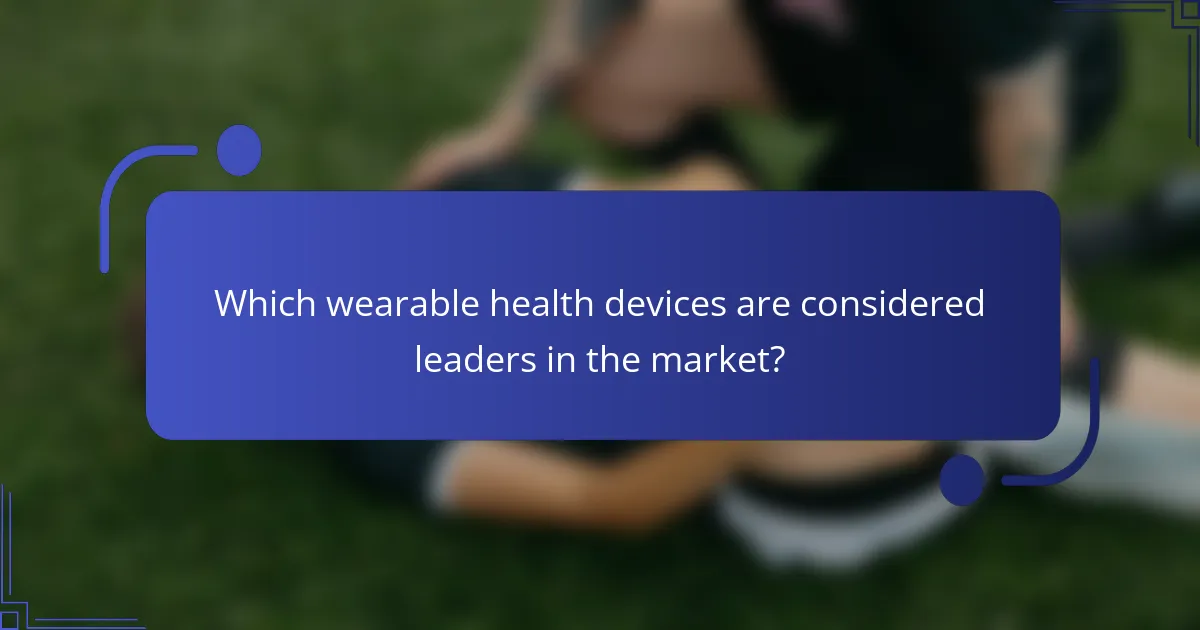Wearable health devices empower users to enhance their fitness, nutrition, and recovery through real-time data tracking. These devices monitor vital metrics like heart rate, steps, and sleep patterns. They also facilitate nutrition tracking by logging food intake and providing personalized recommendations. Leading brands such as Fitbit, Apple Watch, Garmin, and WHOOP offer unique features tailored to individual health management needs.
![]()
How do wearable health devices enhance fitness tracking?
Wearable health devices significantly enhance fitness tracking through real-time data collection and analysis. These devices monitor metrics such as heart rate, steps, and calories burned, providing users with actionable insights.
The integration of GPS technology allows for precise tracking of outdoor activities, improving the accuracy of distance and pace measurements. Additionally, many devices offer nutrition tracking features, enabling users to log food intake and maintain dietary goals.
Recovery tracking is another critical function, as devices can monitor sleep patterns and recovery times, helping users optimize their training regimens. The combination of these features empowers individuals to make informed decisions about their fitness and wellness.
Overall, wearable health devices serve as comprehensive tools that enhance personal accountability and motivation in achieving fitness objectives.
What metrics do fitness trackers typically monitor?
Fitness trackers typically monitor heart rate, steps taken, calories burned, sleep quality, distance traveled, and active minutes. These metrics help users understand their fitness levels and recovery needs.
| Metric | Description |
|———————|————————————————-|
| Heart Rate | Monitors beats per minute during activities |
| Steps Taken | Counts daily steps to encourage movement |
| Calories Burned | Estimates energy expenditure during activities |
| Sleep Quality | Tracks duration and quality of sleep cycles |
| Distance Traveled | Measures distance covered during workouts |
| Active Minutes | Records time spent in physical activity |
How do different devices compare in tracking performance?
Wearable health devices vary significantly in tracking performance across fitness, nutrition, and recovery metrics. Fitness trackers excel in step counting and heart rate monitoring, while smartwatches often integrate advanced features like GPS tracking and personalized coaching. Nutrition-focused devices primarily analyze dietary intake through barcode scanning and meal logging. Recovery trackers emphasize sleep quality and stress management, utilizing heart rate variability as a key indicator. Each device’s performance is influenced by its unique attributes, such as battery life and compatibility with health apps.
What are the benefits of using wearable fitness technology?
Wearable fitness technology offers numerous benefits, including enhanced tracking of physical activity, nutrition, and recovery. These devices provide real-time data, promoting accountability and motivation. They can monitor heart rate, sleep patterns, and calories burned, enabling users to optimize their workouts. Additionally, some wearables offer personalized insights based on individual health metrics, fostering better lifestyle choices. The integration of these devices into daily routines can lead to improved overall health and wellness.
![]()
How do wearable health devices support nutritional tracking?
Wearable health devices support nutritional tracking by providing real-time data on dietary intake and physical activity. These devices often include features like calorie counting, macronutrient breakdowns, and hydration reminders. Users can sync their devices with nutrition apps, allowing for comprehensive tracking of food consumption. This integration enhances awareness of eating habits, promoting healthier choices. Additionally, some devices offer personalized recommendations based on user goals, making nutritional tracking more effective and tailored.
Which features assist in monitoring dietary habits?
Wearable health devices assist in monitoring dietary habits through features like calorie tracking, nutrient analysis, and meal logging. These devices often include sensors that measure physical activity and heart rate, providing insights into the relationship between exercise and nutrition. Integration with mobile apps enhances user experience by offering personalized recommendations based on dietary patterns. Advanced models may even utilize AI to analyze eating habits over time, identifying trends and suggesting improvements.
How do different platforms integrate nutrition tracking?
Different platforms integrate nutrition tracking through wearable health devices that sync data to mobile applications. These devices monitor dietary intake, provide feedback on nutrition goals, and often connect with health ecosystems for comprehensive tracking. Integration varies by platform, with some focusing on calorie counting while others emphasize macronutrient balance. Many devices utilize unique algorithms to personalize recommendations based on user activity and dietary preferences. Popular platforms include MyFitnessPal and Fitbit, which enhance user experience with community features and challenges.
What are the advantages of using wearables for dietary management?
Wearable health devices enhance dietary management by providing real-time tracking of nutritional intake and physical activity. They enable users to monitor their caloric consumption and macronutrient ratios, facilitating informed dietary choices.
These devices often feature personalized recommendations based on individual health data, promoting adherence to dietary goals. As a result, users can achieve better weight management and overall health outcomes.
Additionally, wearables can integrate with health apps, allowing for comprehensive data analysis and progress tracking over time. This connectivity fosters accountability and motivation, essential components for successful dietary management.

How do wearable health devices facilitate recovery monitoring?
Wearable health devices facilitate recovery monitoring by providing real-time data on physiological metrics. These devices track heart rate variability, sleep patterns, and physical activity levels, enabling users to understand their recovery status. For example, a device might indicate when a user is adequately rested or overtraining, helping to optimize workout schedules. The integration of advanced sensors allows for personalized insights, enhancing recovery strategies based on individual needs.
What recovery metrics can be tracked with wearables?
Wearable health devices can track various recovery metrics, enhancing fitness and overall well-being. Key metrics include heart rate variability, sleep quality, muscle recovery time, stress levels, hydration status, and respiratory rate. These metrics provide insights into recovery processes and help optimize training regimens.
How do wearables influence post-workout recovery strategies?
Wearable health devices significantly enhance post-workout recovery strategies by providing real-time data on physiological metrics. These devices track heart rate, sleep quality, and muscle recovery, allowing users to tailor their recovery plans effectively. For instance, wearables can suggest optimal rest periods based on heart rate variability, ensuring adequate recovery time. Additionally, they monitor hydration levels, which is crucial for recovery, helping to prevent dehydration-related fatigue. Overall, the integration of wearables into recovery strategies leads to improved performance and reduced injury risk.
What are the unique recovery features of specific devices?
Wearable health devices offer unique recovery features that enhance fitness and nutrition tracking. These devices typically include advanced metrics such as heart rate variability, sleep quality analysis, and recovery time recommendations.
For example, some devices provide real-time feedback on muscle recovery status based on activity levels and stress indicators. Others may integrate with nutrition tracking to suggest optimal recovery meals.
Additionally, certain wearable devices utilize biofeedback mechanisms to help users manage stress and improve overall recovery. These attributes contribute to a comprehensive approach to health and wellness management.

How do user behaviors influence the effectiveness of wearable health devices?
User behaviors significantly impact the effectiveness of wearable health devices. Active engagement leads to better tracking of fitness, nutrition, and recovery metrics.
Personalization enhances user experience, as tailored features increase motivation and adherence. For instance, users who set specific goals tend to use devices more consistently, resulting in improved health outcomes.
Social interactions also influence behavior. Users who share progress with friends or participate in challenges report higher satisfaction and usage rates. This social support fosters a sense of accountability, encouraging regular use.
Finally, data interpretation plays a crucial role. Users who understand their metrics and receive actionable insights are more likely to adjust their habits, maximizing the benefits of wearable technology.
What factors affect user engagement with fitness wearables?
User engagement with fitness wearables is influenced by usability, personalization, social connectivity, and data accuracy. These factors enhance the user experience and encourage consistent use.
Usability includes intuitive interfaces and easy navigation. Personalization allows users to set goals and receive tailored feedback. Social connectivity fosters community support and competition, enhancing motivation. Data accuracy ensures users trust the information provided, leading to better adherence to fitness plans.
How do cultural differences shape the use of wearable health technology?
Cultural differences significantly influence the adoption and use of wearable health technology. Factors such as health beliefs, technological literacy, and social norms shape how individuals interact with these devices.
In cultures that prioritize individual health management, wearable devices are embraced as tools for personal empowerment. For example, in the United States, users often track fitness and nutrition metrics to achieve personal goals. Conversely, in collectivist cultures, wearable technology may be viewed through the lens of community health, focusing on collective well-being rather than individual metrics.
Moreover, the perception of technology varies across cultures. In some regions, advanced technology is seen as a luxury, while in others, it is a standard part of daily life. This affects the accessibility and usage patterns of wearable devices. For instance, in countries with high technological penetration, such as South Korea, wearable health devices are integrated into daily routines, enhancing fitness and recovery tracking.
Finally, cultural attitudes towards health and wellness influence the specific features of wearable devices that are prioritized. In cultures that emphasize holistic health, users may prefer devices that track a broader range of health metrics, including mental well-being. Overall, understanding these cultural nuances is crucial for manufacturers and marketers aiming to effectively promote wearable health technology globally.
What common challenges do users face with wearable devices?
Users commonly face challenges with wearable health devices, including accuracy issues, battery life limitations, and data overload. Many devices struggle to provide precise readings, leading to user frustration. Battery life can hinder consistent usage, with some devices requiring frequent recharging. Additionally, users often experience information overload from excessive data, making it difficult to focus on key health metrics. Compatibility with other devices and software can also pose integration challenges, impacting user experience.

Which wearable health devices are considered leaders in the market?
The leading wearable health devices in the market include Fitbit, Apple Watch, Garmin, and WHOOP. These devices excel in tracking fitness, nutrition, and recovery metrics.
Fitbit offers comprehensive health tracking features, such as heart rate monitoring and sleep analysis. Apple Watch integrates seamlessly with iOS, providing advanced health metrics and apps. Garmin specializes in GPS-enabled devices ideal for athletes, while WHOOP focuses on recovery and strain tracking.
These brands dominate due to their unique attributes, such as Fitbit’s extensive app ecosystem and WHOOP’s personalized recovery insights. Each device caters to specific user needs, enhancing overall health management.
What differentiates top brands in wearable health technology?
Top brands in wearable health technology differentiate themselves through advanced features, user experience, and data accuracy. They offer seamless integration with mobile devices, personalized insights, and robust health tracking capabilities.
For example, brands like Apple and Fitbit utilize unique algorithms to enhance fitness tracking accuracy. They also provide user-friendly interfaces that promote engagement and adherence to health goals.
Moreover, top brands invest in continuous software updates and community support, fostering a loyal user base. These elements contribute to a holistic approach to health management that goes beyond mere tracking.
In summary, the combination of innovative technology, user-centric design, and ongoing support distinguishes leading brands in the wearable health device market.
How do consumer preferences vary across regions?
Consumer preferences for wearable health devices vary significantly across regions due to cultural, economic, and technological factors. In North America, there is a strong focus on fitness tracking and integration with smart home devices. In Europe, consumers prioritize health monitoring features, such as heart rate and sleep tracking. In Asia, affordability and multifunctionality are key, with many users seeking devices that offer both fitness and health insights at a lower price point. Additionally, regional differences in technology adoption rates influence how consumers interact with these devices. For instance, urban areas tend to embrace advanced features more rapidly than rural regions.
What are the emerging trends in wearable health devices for 2025?
Emerging trends in wearable health devices for 2025 include advanced biometric monitoring, AI-driven analytics, and improved user interfaces. These devices will increasingly focus on holistic health by integrating fitness, nutrition, and recovery tracking.
Biometric monitoring will evolve to include real-time glucose monitoring and advanced sleep analysis. AI-driven analytics will personalize health insights, enabling users to make informed decisions about their wellbeing. Enhanced user interfaces will promote accessibility and engagement, ensuring users can easily navigate their health data.
The integration of wearable devices with telehealth services will facilitate remote consultations, enhancing healthcare accessibility. Additionally, sustainability will become a priority, with manufacturers focusing on eco-friendly materials and energy-efficient technologies.
What should consumers consider when choosing a wearable device?
Consumers should consider compatibility, features, battery life, and user reviews when choosing a wearable health device. Compatibility with smartphones and apps ensures seamless integration. Essential features like heart rate monitoring, GPS, and sleep tracking enhance functionality. Battery life impacts usage frequency and convenience. User reviews provide insights into performance and reliability.
What are the best practices for maximizing the benefits of wearable health devices?
To maximize the benefits of wearable health devices, users should integrate them into daily routines and set specific goals. Regularly updating device software enhances functionality and accuracy. Utilizing data analytics features can provide insights into fitness, nutrition, and recovery patterns. Engaging with community features, such as challenges or social sharing, can increase motivation and accountability. Lastly, ensuring consistent device usage, such as wearing it during workouts and sleep, optimizes data collection and effectiveness.


